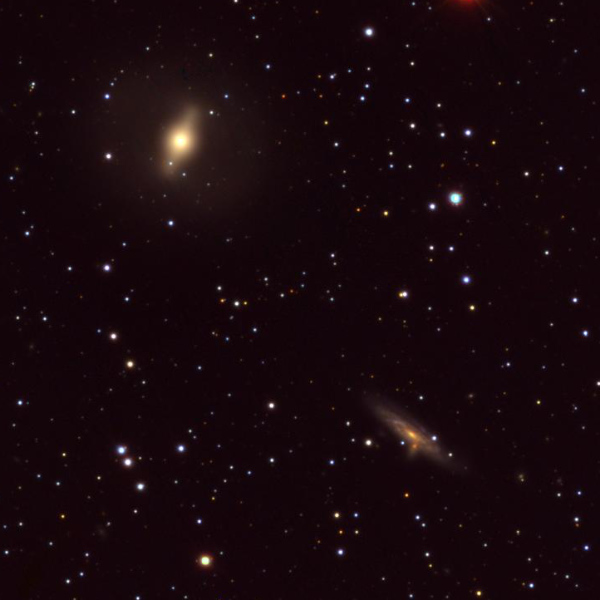July 2017 - Galaxy of the Month
NGC 6548 in Hercules
This month’s challenge is a pair of galaxies in Hercules. NGC 6548 was first discovered by William Herschel in 1786 and is a lenticular galaxy with a very prominent core and a boxy disk. It is classified as an SB0.
NGC 6548 appears to be surrounded on deep images by a halo. The halo appears to show shells in it but I cannot find any good quality deep images of this object, perhaps a challenge for our imaging colleagues.
If it is indeed a lenticular then it is an odd one as normally lenticular galaxies are found in galaxy groups or clusters and this appears to be a field galaxy. However the appearance of the halo and shells indicate that it may have had a dynamically interesting past with mergers so it may have come from there.
The much fainter edge on spiral nearby was found by Marth in 1864 using Lassell's 48” speculum telescope. It was assigned the number NGC 6549 by Dryer and appears to be a type Sbc.
Unfortunately the NGC then got itself into a tangle as Stephan though he saw three galaxies here and the third was given the designation NGC 6550. There is no third galaxy and the NGC 6550 designation appears to be randomly assigned to either NGC 6548 or 6549 depending on which source you look at.
As an example NED says NGC 6548 and NGC 6549 are the same galaxy and incorrectly assigns these numbers to the edge on spiral whilst calling the lenticular NGC 6550. The popular program SkySafari 5 gives the correct designation to NGC 6548 but assigns the primary designation of NGC 6550 to NGC 6549.
Much of this confusion seems to have come from Lewis Swift's comments in his papers.
It would appear that the historically correct designation is that NGC 6549 = NGC 6550 but due to a century of confusion the only way to unambiguously determine which is which is to use the PGC number.

Interestingly NGC 6549 has a much fainter galaxy superimposed on it which almost looks like a jet. The two galaxies are an optical pair with NGC 6549 being three times more distant than NGC 6548. NGC 6548 is believed to be at a distance of about 100 million light years whilst NGC 6549 is at about 310 million light years.
At that distance NGC 6549 would be about the size of our Milky Way with a diameter of about 125000 light years. NGC 6548 is a little smaller with a diameter of perhaps 95000 light years. Unfortunately this confusion means that it is quite difficult to get the correct data and assign it to the correct galaxy.
Neither NGC 6548 or 6549 appear in Night Sky Observer's Guide (NSOG) or in Luginbuhl and Skiff (L&S) so it will be interesting to see what size telescope is required to make out these galaxies and what can be seen.
Owen Brazell - Galaxy Section Director